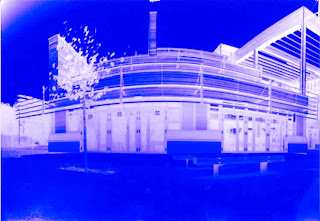What is a photogram?
A photogram is a picture made using objects, photographic paper, an enlarger and chemicals, inside the darkroom. The process of making a photogram begins by placing your object/s onto a piece of photographic paper in any position to create the image you intend to. The next step is to ensure you hahve the correct appeture and timing, and then turn on the light to expose it onto the objects and paper. You then place your image into teh developer; stop and fix to ensure your picture shows up and is secure on the paper. Overall, a photogram is a picture made by shining light onto objects on photographic paper, creating the shape of the objects. The colour (grey or white) of image depends on how dense and dark/light your objects are. If the object was a solid ring, it would turn out white. Whereas if the object was slightly see through, for example: bubble wrap, it would turn out grey with tones of white aswell.
Man Ray is a photographer who created this type of photography; photograms. When he first developed them he named them 'Rayographs'. He discovered this in 1921 in Paris whilst experimenting in the darkroom whilst developing images, and accidently left an object on a piece of paper whilst being exposed to the light.
A photogram made by Man Ray:
I believe that this picture was created using a role of film, aswell as a rubber band on the top left. The way that the film is coiled creates an amazing effect as it shows a contrast with the colours grey, black and white.
Moholy Nagy is an artist who also experimented on photograms. He took on a large amount of design jobs and in 1927-1929 he became an editor of the art and photography department of a magazine made in Europe named International Revue. He was commonly known as one of the 'fathers' of light art as he worked on doing light sculptures and moving sculptures. As he was such a great artist, when he died of leukaemia in 1946, Budapest named a university after him in his honour; Moholy-Nagy University of Art and Design.
A photogram made by Moholy Nagy:
This image by Moholy Nagy is very interesting in comparison to the picture above by Man Ray. This is due to the fact that Moholy has also used a role of film, but has captured the image differently. He has stretched out the role of film more which allows there to be more white and black rather than grey aswell. I also believe that he used a lower appeture to allow more light onto the object and paper, which helps the white colour show.



























